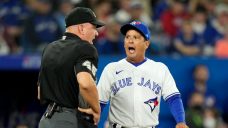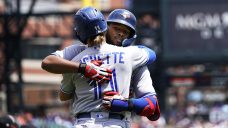CHICAGO — Baseball being baseball, and our planet’s climate emergency being allowed to persist unabated toward ultimate catastrophe, it should have come as no surprise that when Kevin Gausman — the Toronto Blue Jays starter whose recent run of sub-standard results was compounded his last time out by an illness he attempted to pitch through — took the mound Tuesday looking to get himself right, he did so on the hottest day Chicago’s had in a decade.
Just what he needed. A 37-degree Celsius scorcher — various weather services suggested it felt like anywhere from 40 to 44, but, really, what’s the difference at that point? — on which to make his third start in 11 days, regain command of his fastball, sort out a descending arm slot, locate his splitter more effectively, overcome the lack of energy he battled the start prior, and, oh, maybe stop tipping his pitches. No problem for a guy from — checks map — Centennial, Colo., where a hot summer’s day rarely reaches north of — checks historical weather records — 31.
"I didn’t wear tights today," Gausman said. "You just try to drink as much water as you can. Pedialyte."
And that’s not all. Gausman’s last start — a 2.1-inning, seven-run calamity vs. the Baltimore Orioles that he described as "embarrassing" — began a disastrous turn through the Blue Jays rotation in which none of the club’s starters could complete six innings, four of them didn’t see the fifth, and the collective produced a 9.31 ERA over only 19.1 innings, forcing heaps of workload pressure on the club’s beleaguered bullpen.

So, Gausman wasn’t only trying to right his own ship Tuesday — he was trying to right his staff’s as well. And with a six-inning, two-run, 107-pitch, grind-it-out performance against the Chicago White Sox, he did just that. The rest of the night got a little wacky, as things tend to when the mercury rises. Eleven runs were scored from the seventh inning on until the White Sox finally came out on top, 7-6, in the 12th. We’ll get to all that. But the bigger-picture, go-forward takeaway was Gausman’s bounce back at a time both he, and his team, really needed it.
"I thought we did a good job of mixing pitches and making adjustments when we needed to," Gausman said. "Got some big outs. Pitched in a lot of jams and pitched out of them. So, that was nice. But still gave up two runs. So, it's good but not great."
Was he as dominant as he was through his otherwordly first six weeks of the season? No. But Gausman was better than any Blue Jays starter’s been in nearly a week, and better than he’d been himself two of his last three times out. And that’s an encouraging performance the Blue Jays will happily carry ahead.
As is the one Toronto's offence put on against Chicago's bullpen once its starter Dylan Cease (more on him later) was out of the game. First, Alejandro Kirk worked a deep plate appearance against Jimmy Lambert — which included an egregious strike call off the plate by Doug Eddings, who unfortunately became part of Tuesday’s story — before lining a full-count heater 395 feet over the wall in left-centre.
Then, a procession of Blue Jays hitters put up patient, contact-oriented plate appearances against Davis Martin’s fastball-slider mix in the eighth, scratching together walks and softly-hit, perfectly-placed singles to plate a couple more. And Kirk capped it all off with a bases-loaded walk against Jose Ruiz in which he fouled off three 99-mph fastballs before taking one just off the plate, a dicey decision considering the strike call that had gone against him an inning prior.
But all that work was undone in the ninth, as Jordan Romano was simultaneously wild and hittable, walking a pair and giving up three hits to blow his third save of the season in 21 opportunities. Romano’s fastball sitting 96 mph — he’d been around 97-98 in his four prior outings this month — likely had something to do with it. As did the cluster of pitches he left up and over the plate. Ultimately, Romano needed an all-out, game-saving play from Bradley Zimmer in centre to get out of the ninth without taking a loss.
"His command wasn't there, walked a couple of guys — and when you do that, there's always a chance that what happened could happen," Blue Jays manager Charlie Montoyo said of his closer. "He's been great. He just wasn't sharp today."
Off to extras they went, where Vladimir Guerrero Jr. immediately reinstated Toronto’s lead by driving the first pitch of the 10th to the wall in right-centre, plating ghost-runner Bo Bichette from second. But, in the bottom half, Tim Mayza promptly loaded the bases and let Danny Mendick tie it with a soft single to left.
One out, bases loaded, infield in, no problem, as Mayza got Tim Anderson to hit a weak groundball right at Bichette, who started a 6-2-3 double play, extending the game further.
The 11th started with a balk — a balk! — that put Matt Chapman on third where he watched Lourdes Gurriel Jr. get drilled before Raimel Tapia plated him with a single to right. Cavan Biggio bunted the runners into scoring position, but they advanced no further as Bichette and Guerrero each made groundball outs.
Which brought 29-year-old rookie Matt Gage — you know, the guy who was playing independent ball two years ago — in from the bullpen to try to record a save in the first high-leverage MLB appearance of his life with the crazy-fast Anderson starting the inning on second. Off ya go!
The White Sox traded an out to get Anderson to third with a bunt, before Luis Robert lifted a sacrifice fly just deep enough to right, locking the game up again. But Gage kept it right there, striking out Jose Abreu at the end of an eight-pitch battle to send everyone soldiering off for the 12th, the temperature having decreased to a mere 32 degrees, the clock in right field creeping towards 11:30 p.m. CT.
Would this be a good time to mention Wednesday’s game begins at 1 p.m. CT? Because Wednesday’s game begins at 1 p.m. CT. Anyway, the Blue Jays couldn’t get anything going in the 12th, which brought Gage back to the mound from the dugout, glove in hand, to try to keep the White Sox off the board.
And, wouldn’t you know it, he got within a strike of doing it. But Josh Harrison went down to get a slider — Gage’s 29th pitch after he'd thrown a dozen the night prior — at the bottom of the zone and lifted it into centre as the White Sox came streaming from their dugout. Game over. Blue Jays lose. Next one kicks off in about 11 hours.
"I've never been in an extra-inning game that you lose where it's not tough. So, that's just another one," Montoyo said. "And, of course, they always become a little tougher when you had a chance to win it and then you blew the save. But our closer's been one of the best closers in baseball. He just didn't have it today."
Also from the bad news department, there’s the matter of George Springer, who left the game prior to his fourth plate appearance of the night with right elbow discomfort. That situation will obviously bear monitoring going forward and it is at least notable that Springer struck out three times Tuesday and entered the game in a 2-for-23 slump over his last half-dozen games.
"He's probably not going to play tomorrow," Montoyo said. "He's been playing with that a little bit. But today it bothered him even more."
Of course, it’s tough to fault Springer for striking out three times against Cease. Everyone was striking out against Cease. The 26-year-old was electric, running his fastball up to 99, striking out 11, and leaning heavily on his boomerang slider to generate 18 whiffs on 28 swings. The pitch's ridiculous movement and the fact he was able to land it for eight called strikes is what made it so difficult for the Blue Jays to lay off of. And yet, not helping matters was the consistency with which Cease received called strikes off the plate against right-handed hitters:

Now, it would be one thing if Cease was getting those calls with his slider and curveball, which each move an absurd amount and test the depth perception of umpires every time he’s on the mound. Incorrect rulings are to be expected when asking a human to judge the location of a small object — one moving unpredictably with extreme velocity — within a variable, imaginary box in real time.
But it’s another when Cease is getting fastballs off the plate, like the first-pitch strikes he got against Kirk and Santiago Espinal in the second, and the 2-0 call he received on a heater that was — generously — six inches off the black to Guerrero with a runner on in the fourth.
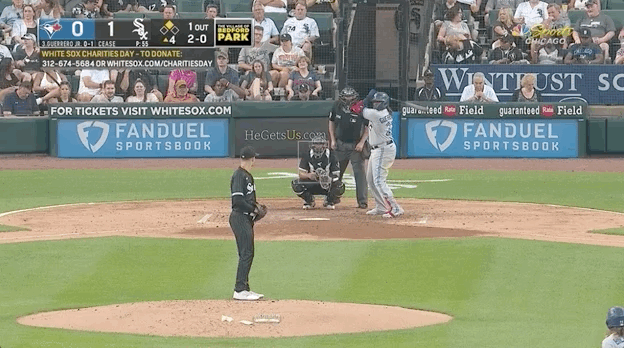
Eddings' zone was a mess all night, a matter he was loudly informed of by each team's dugout at various points in the game. He had heated exchanges with hitters and coaches from both sides. Blue Jays pitching coach Pete Walker was ejected for arguing in extras. No matter which side you were on, it was maddening to watch:

But the Blue Jays gave Cease plenty of strikes themselves, whiffing 20 times on the night, the majority of them chasing sliders that started on the plate and finished nearly in the dirt. Cease did a phenomenal job of staying away from Toronto’s righty-heavy lineup, starving Toronto hitters of anything they could turn on.
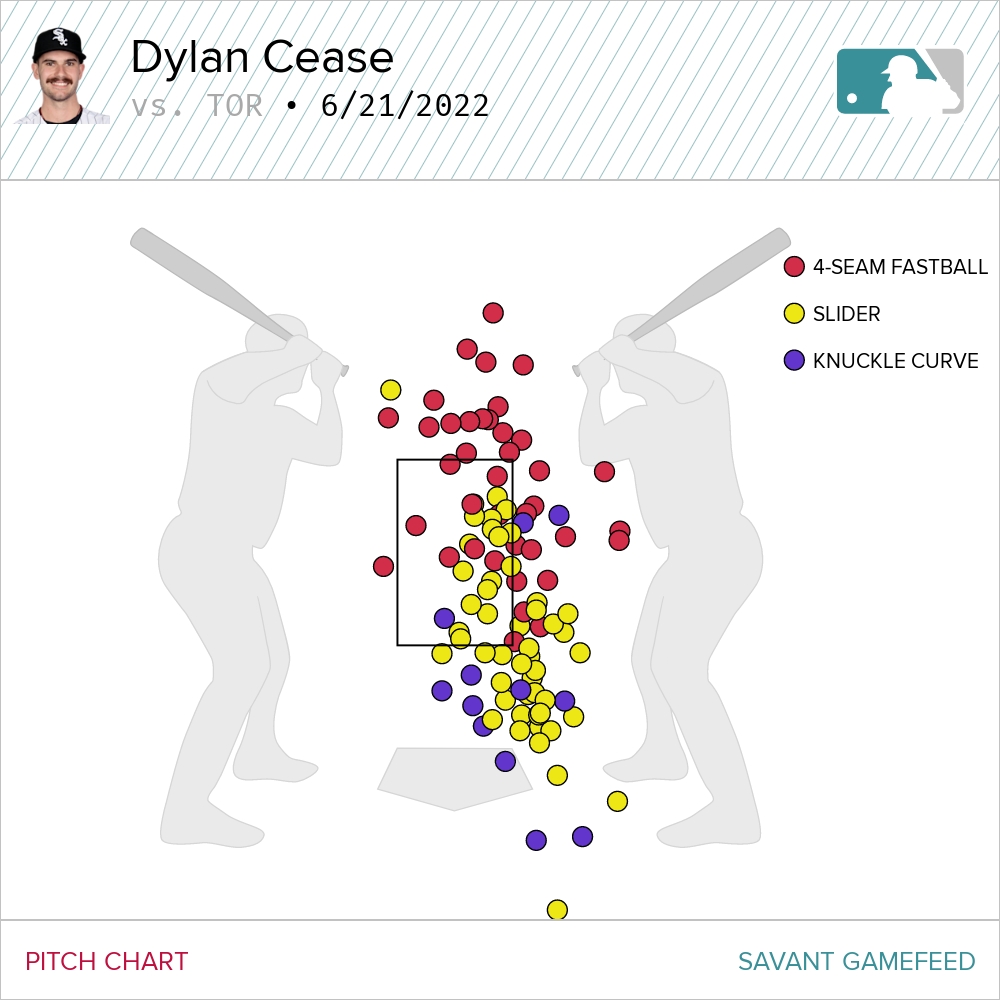
Toronto’s best opportunity came in the fourth, when Bichette worked only his second walk in the last two weeks and promptly stole second, the 33rd time a base-stealer had been successful against Cease in 38 career attempts. But with one out and Guerrero at the plate in a 2-1 count, Bichette gambled he could take third as well and lost thanks to a strong throw from catcher Seby Zavala.
Two pitches later, Guerrero walked. Seven pitches after that, Kirk grounded out to end the inning. And it wasn’t until the sixth that the Blue Jays came up with their first hit, as Gurriel beat out a grounder deep in the hole at short. But Gurriel remained right there as Springer went down swinging before Bichette was run up on another pitch you may want to see again:
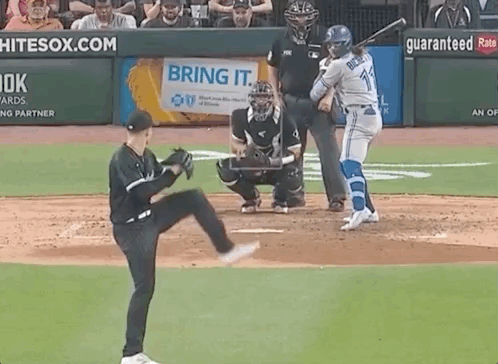
It really do be like that sometimes. And to be fair, Gausman received three generous rulings of his own in and off the plate to right-handed hitters on a night when Eddings' strike zone was encroaching on the batter's boxes.
Each time it helped get Gausman into a leverage count, most crucially in his sixth inning when he had a runner in scoring position and only one out. Gausman finished that frame with a pair of strikeouts, his sixth and seventh of the night, stranding that critical run at third. In all, he threw 71 of his 107 pitches for strikes, earning whiffs with each of his four-seamer, splitter, slider and changeup.
Gausman’s struggles his last time out against Baltimore obviously weren't helped by the fact he spent part of his pre-game routine receiving intravenous fluids after a virus his son brought home quickly tore through the household. But it’s not like that rough outing was isolated. He was touched up by the Twins two starts prior, and matched a season-low with only five completed innings the start before that. After pitching to a 2.25 ERA — and 1.31 FIP suggesting he actually deserved better — through his first nine outings of the season, Gausman posted a 6.35 mark — a 3.19 FIP again telling a different story — over his next four entering Tuesday.
Of course, we know ERA isn’t everything. But something clearly was amiss. And while the possibility of tipping his pitches was an ongoing concern from earlier in the season when the Seattle Mariners appeared to have something on him, a mechanical inconsistency was a new one. The vertical release point of Gausman’s fastball — all of his pitches, really — had quietly dipped below six feet after staying above that mark over the two months prior:
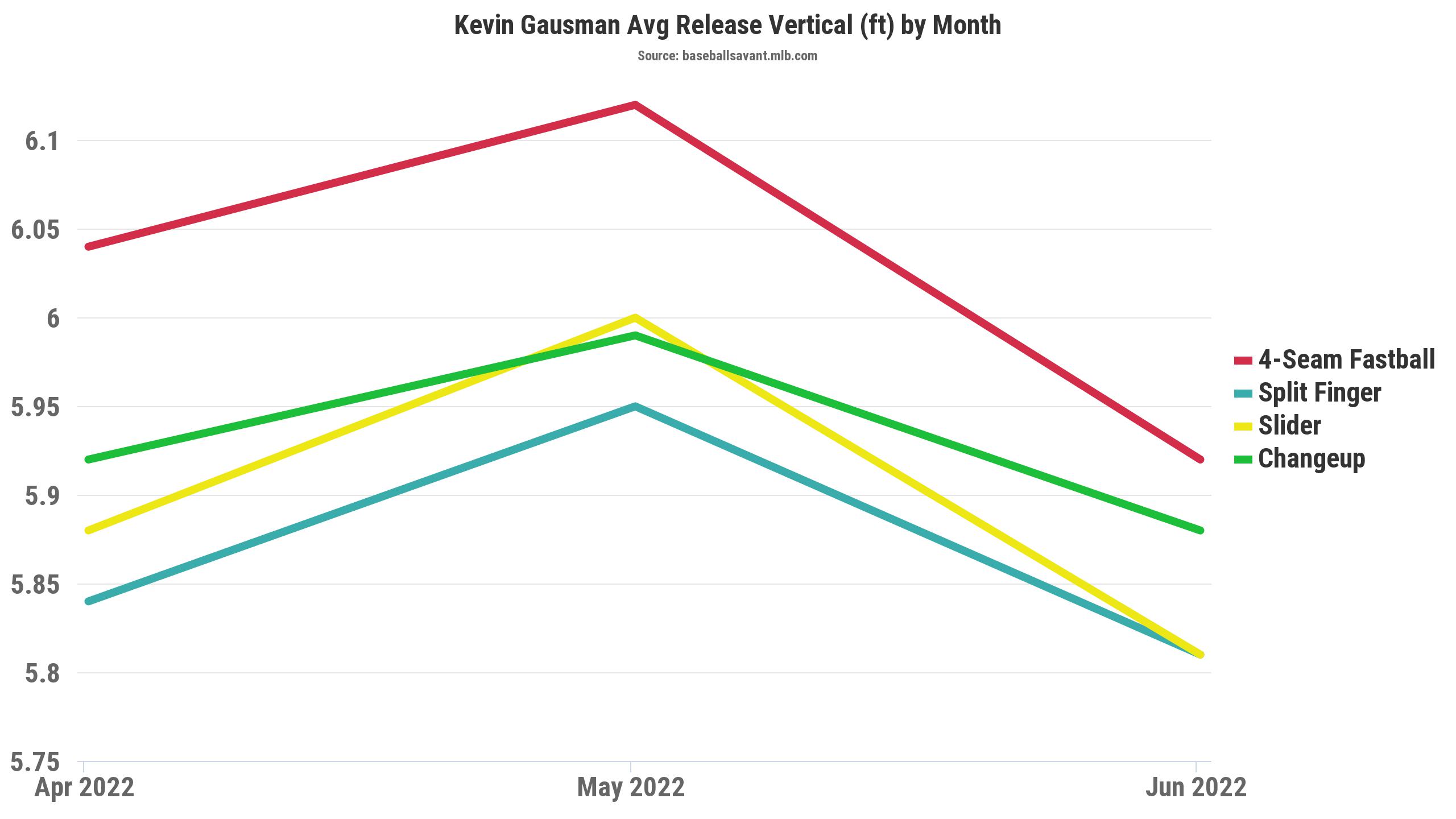
Now, we’re only talking a matter of inches here. But so much of Gausman’s success is tied into the repeatability of his delivery — whether he can make his splitter look like a fastball out of his hand and vice versa — that a fluctuation like this can't be written off as insignificant.
Gausman had also been working to mix in more fastballs down in the zone in order to camouflage the fastballs-up, splitters-down pattern he'd established over his first 10 starts of the season. When Gausman struggled earlier this month against the Minnesota Twins, he averaged his highest fastball height, third-lowest splitter height, and largest discrepancy between those two numbers of any start this season. Coupled with the fact Gausman's splitter rarely lands on the plate, that approach made it too easy for hitters to set their sights on anything up, while letting anything down go by.
But it’s easy for us to say "just throw your fastball down more often" — not so easy to execute it on the mound. Gausman was trying against the Orioles, but ended up driving too many of those fastballs well below the zone. He was also yanking his splitter off the plate arm-side, which made it easier for hitters to take.
Those big misses drove up his pitch count early. And as Gausman tried to adjust through fatigue, he began leaving pitches with diminished velocity and action up over the plate, which is when the real damage began. The Blue Jays coaching staff was well aware of how sick Gausman was that day and were closely monitoring those velocity and movement readings from the dugout. That explains why Gausman was lifted 17 pitches into his third inning of the day, and only 53 pitches into his outing.
And while his command was inconsistent at times on Tuesday, and his release point wasn’t quite where it was earlier in the season, the overall package was better. Considering how things had been going lately, for Gausman and the rest of the starting staff, the Blue Jays will take it.
After four hours and 23 minutes of baseball in mid-30 degree heat, with Wednesday's game starting about 11 hours after Tuesday's ended, they would’ve taken a win, too.
